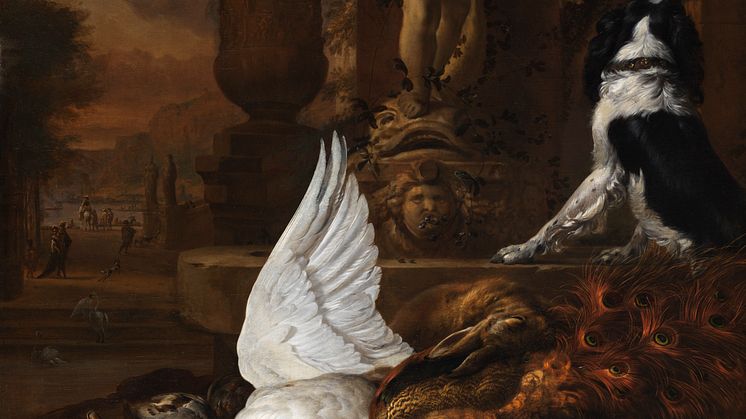
Press release -
New Acquisition: A Hunting Still Life by Jan Weenix
Nationalmuseum has acquired a large, masterfully executed game still life dating from 1684 by the Dutch Baroque painter Jan Weenix. The painting represents dead game placed next to a sculpted fountain in the shape of a putto. The canvas formerly belonged to the Swedish diplomat and collector Karl Bergsten and has now been reunited with those parts of his extensive art collection previously in the museum’s holdings.
Jan Weenix (1640-1719) was a highly successful painter in his day, celebrated for his game still lifes and hunting scenes. His father, Jan Baptist Weenix (1621-1660/61), and cousin, Melchior d'Hondecoeter (1636-1695), were both acclaimed artists, and it was from them that he learned his trade. Weenix was born in Amsterdam in 1640, but by 1649, his family had settled in Utrecht, where he eventually became a member of the painters' guild of Saint Luke. By 1677, he had moved to Amsterdam, where he continued to reside until his death in 1719. His first works, from the 1660s, are genre scenes set in Italianate landscapes or exotic ports modelled after his father's compositions. After 1680, he gradually abandoned these popular themes in favour of the game still lifes and flower pieces for which he is best known.
Already in his early game pieces such as this large and ambitious painting, signed and dated 1684, Weenix shows the full command of a master. Exquisitely painted and observed, the picture evokes the image of an idyllic park landscape with a strolling amorous couple and an exotic harbour scene in the distance. The central motif combines meticulously rendered animal trophies (a swan, a peacock, small birds, a hare) and hunting gear (a gun, a pouch, a hunting horn), decoratively arranged at the base of a sculpted fountain. A longhaired black-and-white hunting dog seated on the fountain-base is shown suddenly distracted by a dove beating its wings, which adds a lively note to the composition. Like his cousin Melchior d'Hondecoeter, Weenix became famous for rendering the textural and colouristic beauty of his subjects. A characteristic of his work is his inimitable application of paint in rendering different textures such as an animal’s pelt or plumage. Here the various textures of the birds’ rich plumage are skilfully reproduced in nuances ranging from a soft and shimmering silky white to a hard metallic blue. The predominantly subdued colours of the surrounding landscape and the soft evening light impart warmth and luminosity to the still life’s more saturated colours.
Elegant hunting or trophy still lifes were much in demand in Holland in the 17th century. Hunting was a royal sport and a favourite aristocratic pastime, strictly regulated and illegal even for the rising bourgeoisie. It has therefore been suggested that game still lifes were often acquired by wealthy burghers in order to lend themselves a degree of social prestige. At the beginning of the 18th century, hunting still lifes became increasingly popular for wall decorations, and many of Weenix’s works were painted to order as wall-panels. Justly famous is his series of large game pieces painted between 1702 and 1712 for the hunting lodge of Johan Wilhelm, Elector of the Palatine, at Bensberg near Düsseldorf. These have been interpreted as allegories of abundance placed at the feet of the Elector. Goethe saw these impressive canvases in situ in 1774, and observed that Weenix had surpassed nature in visually rendering every tactile value of his subject.
The painting comes from the art collection of the Swedish businessman and Consul General Karl Bergsten (1869-1953), housed in the Villa Dagmar in Stockholm. Its acquisition by the museum was made possible by generous donations from the Axel and Nora Lundgren Fund and the Wiros Fund. Nationalmuseum has no budget of its own for new acquisitions, but relies on gifting and financial support from private funds and foundations to enhance its collections of fine art and craft.
Press contact
Carina Fryklund, Senior Curator, Collections and Research, carina.fryklund@nationalmuseum.se, +46 8 5195 4475
Hanna Tottmar, Press Officer, press@nationalmuseum.se, +46 767 23 46 32
Categories
Nationalmuseum is Sweden’s premier museum of art and design. The collections comprise older paintings, sculpture, drawings and graphic art, and applied art and design up to the present day. The museum building is currently under renovation and scheduled to open again in 2018. In the meantime, the museum will continue its activities through collaborations both in Sweden and abroad as well as temporary exhibitions at Nationalmuseum Design at Kulturhuset Stadsteatern in Stockholm. Nationalmuseum has partnerships with Svenska Dagbladet and the Grand Hôtel Stockholm, and acknowledges the support of FCB Fältman & Malmén.

